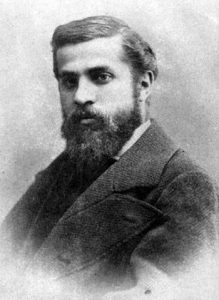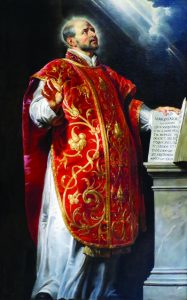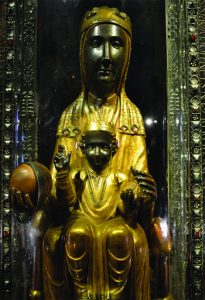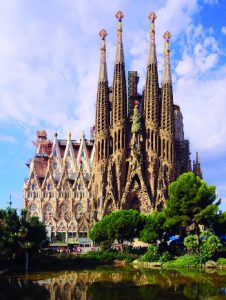The Helping Hand of Mary
When we pray to Mary we can pray to her anywhere - in the quiet of our homes, at church, on our way to somewhere. We can also pray to Mary at a special pilgrimage site where Mary’s presence is especially honoured. There’s Lourdes in France, Guadalupe in Mexico and Montserrat in Spain, among many others. If you made a pilgrimage to one of these places, what do you think Mary would say to you? Saint Ignatius and Antoni Gaudi have something in common there. They both made visits to Our Lady of Montserrat in Spain.
By looking at their lives, you can see how Mary guided them, and from there we can get an inkling of how Mary would also answer our prayers to her, whether we are at a pilgrimage site, or simply lifting our thoughts to her in the quiet of our hearts wherever we find ourselves.
You will find Our Lady of Montserrat high in the hills above Catalonia, Spain, in the Church of St Cecilia, of the Benedictine monastery of Montserrat. She sits at the front of the church, above the altar, in a specially created space called the throne room.
You can see her as soon as you enter the church and, though the image is far away, you can still make out the shape of Mary seated and the Christ child sitting in her lap. You can also see that the faces and hands of Mary and the Christ child are black, and hence it is also known as The Black Madonna.
The colour black represents mystery and holiness. In the statue, the colour black is telling us that the Christ child is our one true God of mystery and holiness and that Mary, Mother of God, has been touched by the mystery and holiness of God, and that she too is holy. Many people have been coming to visit her since the twelfth century -- that’s over 800 years! Her most noted pilgrim is St Ignatius of Loyola (1491-1556). A more recent visitor is the Spanish architect Antoni Gaudí (1852-1926). They visited Montserrat during turning points in their lives, and after their prayers to Mary, their lives were turned in new directions.
St Ignatius visited Our Lady of Montserrat on 25 March 1522. He was already a changed man, but his future direction was still unclear. In the previous year, he had received a serious battle wound. While recovering from his injuries, he read two books -- one on the life of Christ, and the second on the lives of the saints. He was introduced to the idea of meditating on the life of Christ and this became the inspiration for his later writings. He also realised that the lives of the saints moved him and filled him with a lasting joy, in a way that his worldly life could not.
When he was well enough he made his way to Montserrat. There he prayed and made his confession. Ignatius spent the night before he left Montserrat on his knees or standing in front of the Black Madonna, and it is in front of her that Ignatius left his sword and dagger. Immediately after his time with Our Lady, Ignatius found himself a short distance away in Manresa, Catalonia. One wonders if Our Lady sent him there. He spent about a year in prayer, fasting, using ascetic practices, and struggling through doubts, fears and scruples, before finally emerging as a man at peace, and with the first draft of his spiritual exercises written down in a note book. These exercises have been widely used and are still being used today. They provide a space in one’s life to reflect, pray, discern and act upon our individual call to follow Christ. Ignatius’ journey led him to found the Jesuits in September 1540, a religious order that today is especially renowned for its promotion of education through excellent colleges and universities throughout the world.
In Wikipedia there is a photo of Antoni Gaudí visiting Montserrat in 1904. At that time he was at the peak of his architectural career. His next two projects, the apartments Casa Batillo (1904-06) and Casa Mila (1905-10), show Gaudí’s mature architectural style, using nature for inspiration, combining practical solutions with creative flair, with workmanship of a high standard, including attention to detail, and using innovative construction techniques. Gaudí was flying high. His reputation was established and the world was his oyster. However, his prayers and reflections, including his conversations with Our Lady from Montserrat, were turning him in a different direction.
Since 1883 Gaudí was not only taking on private work but was also in charge of the construction of the church Sagrada Familia. But in 1910, when at the peak of his achievements, he turned his back on the high life and spent the rest of his life working fulltime on the construction of the church. He knew he wouldn’t see it finished, but he built enough to give a guide line to whoever followed after him. Some of his successors have included architects from both New Zealand and Australia.
Gaudí built the exterior nativity facade of the church. In the central exterior stone work display, is the story of the nativity and, above it, like an enveloping umbrella, sit the hills of Montserrat. The same Mary from the two places is now linked in stone by Gaudí -- Mary from Bethlehem and Mary from Montserrat. The church will be completed in 2026, one hundred years after Gaudí’s death. It could not be a more beautiful church to honour the presence of the blessed Eucharist and to celebrate Mass. It draws millions of people from all over the world to stare at it in awe and wonder.
You can see Mary’s influence on the lives of these two holy men. Just as in the statue of the Black Madonna, where Mary draws attention to the Christ child on her lap, so has Mary drawn these men out of this world and towards her Son. So astounding has been their meeting with her Son, that their work has produced a wake through which others are also drawn to Christ, through prayer, reflection, study, and through architecture that is awe-inspiring and that brings many people closer to His presence in the Eucharist.
Their actions seem to step outside of time, because the benefits of their work just go on and on -- for St Ignatius, from the 1500s until the present, and for Gaudí, from the 1800s until the present.
We too will find that before Mary, we will be turned towards her Son. We may not be called to found a religious order or design a church, but we will be taken by Mary’s hand to meet her son Christ in our lives, and by incidental consequence, it will provide a path that others too might follow in our wake. We follow in the wake of our ancestors’ faith and Christian example. Through our attitudes and prayers, those around us will be taking note, absorbing our faith and being comforted by it. Those Hail Marys muttered under our breath that give us the courage to do the right thing according to God’s will, are prayers that take us straight to Christ the Good Shepherd.
And so what does the Good Shepherd say to us? What he always says. Take courage. Have faith. Love one another. But it does not sound as if He is repeating it for the millionth time. No, rather it sounds as if he is speaking directly to us, in the need of the moment, and if we could just pull back the veil, we could see him standing there and smiling at us. It warms us thoroughly to the core and gives us the strength to stand up and carry on.





 Entries(RSS)
Entries(RSS)